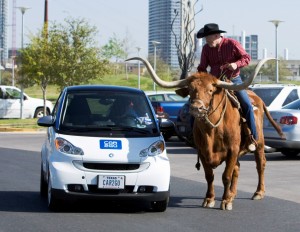There’s a huge disconnect between natural small car demand in the U.S. and the number of small cars that makers will actually have to sell by 2016 to meet the proposed 35.5 mpg standard, according to Charles Chesbrough of CSM Worldwide consultancy.
The senior economist, in a data packed presentation today to the Automotive Press Association in Detroit, explained that to meet the standard by 2016, American new car sales of tiny A, B, and C-segment cars would have to be the same as they are in Europe today. This to me is an almost inconceivable shift, given previous behaviors from politicians and consumers. C-cars are Ford Focus, Toyota Corolla or Honda Civic in size.
In Europe, these small cars account for more than 40% of the 2009 market. While in the U.S., they represent about 5%.
How a eightfold increase in tiny car sales will be forthcoming, when U.S. gasoline prices are currently averaging $2.50 a gallon, down from a record $4 in the summer of 2008, is a huge political issue.
In Europe, of course, heavily taxed gasoline is in the $6.50-$7.50 a per gallon range. Would the Obama Administration dare to impose a $4 a gallon tax? This is only one of the nettlesome policy issues facing politicians.
U.S. energy policy – rather, the lack of the political will to impose one, we observe, going back to the first fuel crisis in 1973 — has left us as dependent today on a disruption in oil supplies as then. This remains a clear national security threat, as well as an economic one given the current fragile state of the economy.
The startling CSM sales analysis comes as a U.N. Climate Change conference in Copenhagen opened, which begins a year-long process that will likely result in rules eventually calling for an 80% reduction in CO2 gases by 2050. G8 countries have already endorsed this.
However, the next year will be spent arguing about how to stabilize CO2 emissions by 2020. It is expected that later this month President Obama will propose a 17% reduction in U.S. green house gases. CO2 production is directly related to the amount of any carbon-based fuel that is burned, so CO2 regulations are in effect fuel economy regulations. Conceptually, you could be looking at a new vehicle fuel economy average of 100 mpg.
The more immediate issues facing automakers, which will have drastic effect on the types, size and cost of cars that you will able to buy, surround what EPA and DOT will do for the 2012-2016 period, and what California will propose for the years thereafter. Will a European model be embraced so that the U.S. remains part of the global economy and can meet greenhouse gas regulations?
Automakers are facing unprecedented spending to meet fuel economy and safety regulations at a time when the Great Recession is still dragging on. No wonder, then, that they are calling for a single, stable and long-term energy policy in the U.S. They need to know know what the price of gasoline will be, so they can plan production accordingly.
How miles per gallon are measured, what credits are allowed, and whether the government will give automakers more money to convert to new technologies are open — and contentious — issues.
As are the fines imposed on makers – passed on to customers in the past — who fail to meet the standards. In the current EPA rules, the agency has the power to impose fines of up $37,500 per vehicle. In its discussion of the upcoming joint EPA-NHTSA greenhouse gas and fuel economy rules, the newly militant agency raises the possibility that it would do so if a maker does not meet the CO2 standard. It is uncertain if EPA would impose such a large fine, but it would certainly make a vote-getting point if it did so.
One thing is certain – makers do need a stable planning environment, which has not existed. And voters have a right to know what they can expect as well.

